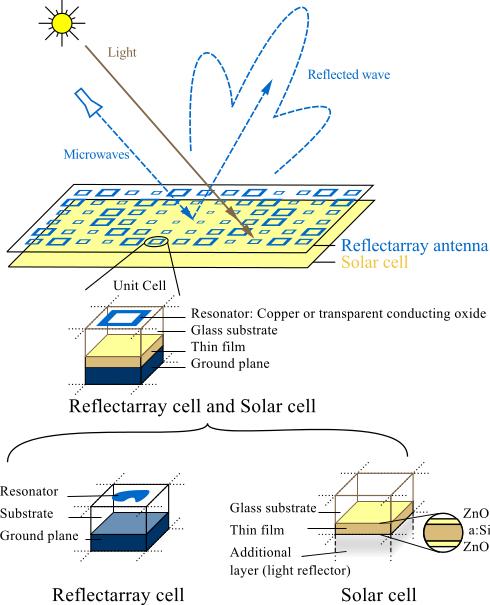Combining antennas with solar panels for high efficiency, low weight and volume
December 3, 2013

(Credit: EPFL)
Traditionally, antennas and solar cells have never worked well together, as they have to function independently of each other in order to avoid interference. This has an impact on the weight and size of satellites — the surface area has to be large enough for both antenna systems, which emit and receive data, and solar panels, which supply the electricity.
Now EPFL’s Philippe Dreyer has developed a mixed surface that allows both the antenna and the photovoltaic cell to perform extremely efficiently.
This could substantially reduce the volume, weight and cost of satellites, as well as mobile communications systems used to keep in contact with people after a natural disaster. This new technology would make these systems lighter and therefore easier to carry around. They could also be folded up.
For their study, the researchers used reflectarray (RA) antennas, which have the advantage of being flat, relatively cheap, and highly efficient. These antennas were combined with thin-film amorphous-silicon solar cells, which are light and resistant to radiation.
In the device, a set of conductors (resonators) is placed on top of the solar cells. This layering makes it possible for the cells to maintain up to 90% of their photovoltaic efficiency.
Abstract of arXiv paper
This work addresses the integration of reflectarray antennas (RA) on thin film Solar Cell (SC) panels, as a mean to save real estate, weight, or cost in platforms such as satellites or transportable autonomous antenna systems. Our goal is to design a good RA unit cell in terms of phase response and bandwidth, while simultaneously achieving high optical transparency and low microwave loss, to preserve good SC and RA energy efficiencies, respectively. Since there is a trade-off between the optical transparency and microwave surface conductivity of a conductor, here both standard copper and transparent conductors are considered. The results obtained at the unit cell level demonstrates the feasibility of integrating RA on a thin-film SC, preserving for the first time good performance in terms of both SC and RA efficiency. For instance, measurement at X-band demonstrate families of cells providing a phase range larger than 270{\deg} with average microwave loss of -2.45dB (resp. -0.25dB) and average optical transparency in the visible spectrum of 90% (resp. 85%) using transparent conductive multilayer (resp. a copper layer).
(¯`*• Global Source and/or more resources at http://goo.gl/zvSV7 │ www.Future-Observatory.blogspot.com and on LinkeIn Group's "Becoming Aware of the Futures" at http://goo.gl/8qKBbK │ @SciCzar │ Point of Contact: www.linkedin.com/in/AndresAgostini
 Washington
Washington